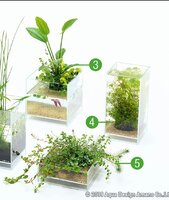Sarpijk
Member
- Joined
- 11 Jan 2015
- Messages
- 701
Hi guys!
After creating my first diy wabi kusa ball and with some free time in my hands I have decided to create one with an emersed Echinodorus.
I have fallen in love with the wabi kusa arrangements from ADA. Never have I kept an Echinodorus so I would like to know if there are specific subspecies or cultivars for such a project.
I have seen Echinodorus Argentinensis and it looks it would fit. Any other suggestions maybe other than total green?
I have attached a picture(3) to show you what I have in mind ( minus the expensive branded glassware)

After creating my first diy wabi kusa ball and with some free time in my hands I have decided to create one with an emersed Echinodorus.
I have fallen in love with the wabi kusa arrangements from ADA. Never have I kept an Echinodorus so I would like to know if there are specific subspecies or cultivars for such a project.
I have seen Echinodorus Argentinensis and it looks it would fit. Any other suggestions maybe other than total green?
I have attached a picture(3) to show you what I have in mind ( minus the expensive branded glassware)










